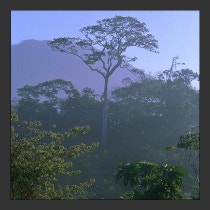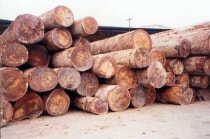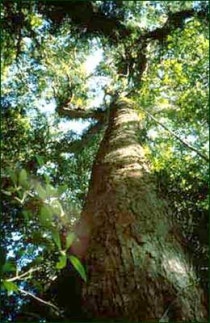
- Filipino: apitong
- Malay: keruing belimbing
- Lao: ຍູງ (ɲúːŋ)
- Thai: ยางยูง (ˈyaaŋ ˈyuuŋ) / ยูง (ˈyuuŋ).
Apitong and Other Dipterocarps
Many giant trees of the lowland rain forest are members of the hardwood family called dipterocarps, known to Filipinos by such names as apitong, bagtikan, lauan, tangile, guijo, and yakal. The crowns of these trees extend 30 to 50 meters high, and their trunks may reach almost two meters in diameter. Reinforced with buttresses that flare out from the base of the tree, the trunk grows straight and is 25 to 30 meters long, characteristics that make these trees especially desirable as timber. Dipterocarps once constituted 80 percent of the country's timber resources and provided the bulk of what is sold on the market as "Philippine mahogany." Although best used for fine furniture these woods have also been used for railroad ties, utility poles, bridges and wharfs, pulp, paper, and plywood. One species (Dipterocarpus grandiflorus), known as apitong in the Tagalog language and agagkag in Visayan, yields and oily resin, called balaw, which is used in lamp oil, varnish, and caulking compounds.
Forty-five species of dipterocarps are indigenous to the Philippines, of which nearly half are found nowhere else. The current distribution of these trees in the Philippines resulted from the configuration of land during the last glacial period, with many dipterocarp species confined to a single Ice-Age island. Even though the fruits of dipterocarps have wing-like appendages that produce a parachute-like motion when they fall, they are too heavy to be carried far from the parent tree; many land directly under the tree, leading to overcrowding and forcing them to compete for space. The seeds cannot survive for long periods at sea. These limitations on the dispersal of the seeds isolated populations &led to the evolution of many new species.
Philippine old-growth dipterocarp forests have almost entirely disappeared. Several species once fairly common in primary lowland forests in many parts of the country have been decimated by logging and slash-and-burn agriculture. These trees generally take at least 40 years to produce their first seeds, and 100 years to reach timber size. Ever-increasing demand and the nearly exhausted supply have made logging companies even more zealous to exploit the last remnants of forests on Palawan, Mindano, and Luzon.




|
Dipterocarpus grandiflorus |
|---|
| Scientific classification |
|
|
|
Kingdom : |
|
|
(unranked) : |
|
|
(unranked) : |
|
|
(unranked) : |
|
|
Order : |
|
|
Family : |
|
|
Genus : |
|
|
Species : |
D. grandiflorus
|

